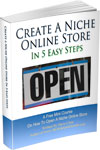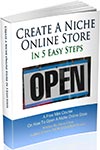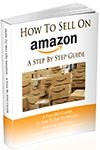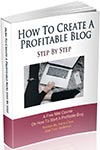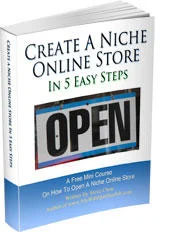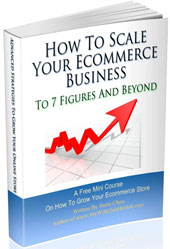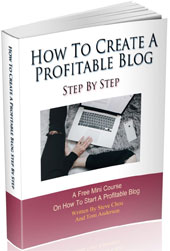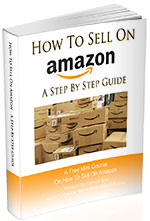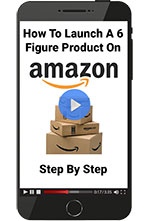Podcast: Download (Duration: 49:22 — 56.8MB)
In this episode, I sit down with Kurt Elster, host of The Unofficial Shopify Podcast, to talk about how AI is shaking up ecommerce and changing the way Shopify brands grow.
We discuss the new AI tools that are actually moving the needle, boosting conversions, streamlining operations, and increasing average order value.
Get My Free Mini Course On How To Start A Successful Ecommerce Store
If you are interested in starting an ecommerce business, I put together a comprehensive package of resources that will help you launch your own online store from complete scratch. Be sure to grab it before you leave!
What You’ll Learn
- The top Shopify features boosting big brands.
- How to leverage AI for sales growth.
- How to optimize your store for conversions.
Sponsors
SellersSummit.com – The Sellers Summit is the ecommerce conference that I’ve run for the past 8 years. It’s small and intimate and you’ll learn a ton! Click Here To Grab The Recordings.
The Family First Entrepreneur – Purchase my Wall Street Journal Bestselling book and receive $690 in free bonuses! Click here to redeem the bonuses
Transcript
Welcome back to the podcast, the show where I cover all the latest strategies and current events related to e-commerce and online business. Now in this episode, I sit down with Kurt Elster, host of the unofficial Shopify podcast to talk about how AI is shaking up e-commerce and changing the way Shopify brands grow. We discuss the new AI tools that are actually moving the needle, boosting conversions, streamlining operations and increasing AOV. And it doesn’t matter if you aren’t on Shopify, you will get a lot out of this episode. But before we begin,
00:28
I want to let you know that tickets for Seller Summit 2026 are now on sale over at sellersummit.com. And if you sell physical products online, this is the event that you should be at. Unlike most e-commerce conferences that are filled with high level fluff and inspirational stories, Seller Summit is all about tactical, step-by-step strategies you can actually use in your business right away. Every speaker I invite is deep in the trenches, people who are running their own e-commerce stores, managing inventory, dealing with suppliers, and scaling real businesses. NOAA corporate execs,
00:57
no consultants. Also, I hate big events, so I intentionally keep it small and intimate. We cap attendance at around 200 people so you can actually have real conversations and connect with everyone in the room. We have sold out every single year for the past nine years, and I expect this year to be no different. It’s happening April 21st to 23rd in Fort Lauderdale, Florida, and if you’re doing over $250k or $1 million in revenue, we also offer a private mastermind for high-level sellers.
01:25
Right now, tickets are the cheapest they’re ever going to be. So if you want in, go over to sellersummit.com and grab your ticket. Now on to the show.
01:39
Welcome to the My Wife Quarter job podcast. Today I’m excited to have Kurt Elster on the show. I’ve known Kurt for over a decade now. He is the founder of EtherCycle where he helps Shopify owners grow their businesses. And he is also the host of the unofficial Shopify podcast, one of the best and longest running e-commerce podcasts out there. Now it’s been a while since I’ve had Kurt on and with AI shaking up e-commerce so quickly,
02:09
I wanted to bring him back on today to talk about the strategies some of the biggest brands and his clients are using right now to increase average order value, boost conversions, and grow revenue. And with that, Kurt, how are you doing? Good. I’m happy to be here. You know, first interview of the day. I think I have known you for over a decade, right? 2014, I want to say is when… Yeah, know. We were at like pre-pandemic. I know the first time I met you in person, pre-pandemic, it was Klaviyo, Boston. Yeah.
02:38
Yeah, was that 2016 or something like that? I don’t even remember. I don’t know. It’s been a while. But it’s great to have you. In all my years running my e-commerce store, this is my 18th year. I would say outside of COVID, this year has easily been the most tumultuous with crazy changes across the board with AI and tariffs. So my first question for you, since you have a lot of clients, what are your clients doing about tariffs right now?
03:07
through the grade buy. This is what’s crazy. The tariffs really a lot of it is just about communicating it. And so the the practical change I’ve seen is if you’re on Shopify plus adding checkout messaging where it’s like you know that based on address or the product that this order will incur some kind of know tariff duty or tax potentially and just surfacing that upfront. It’s like hey you know this isn’t us but this is what you’re going to be looking at. ah
03:35
Or helping people try and get like delivery duty paid set up DDP with international shipping. Or even just getting HS codes harmonized system which is what like tariff tax tariffs use to identify what kind of product they’re looking at. Just getting those set up so that people could pay the appropriate taxes like just being prepared for it is tough. I mean the really tough part is like day to day even like between now and this recording and when it airs.
04:05
It’s chaotic. know, we don’t know. At no point have I been able to tell you what tariff you may or may not pay on what order when. Like that’s what’s so confusing and concerning about it. I’m pretty shocked. So you’re saying some of your clients are in the checkout, letting people know that the prices instead of just increasing prices across the board, you are indicating like a tariff fee? That yes, some have done it that way.
04:34
where they know that like, all right, we’re not covering it, but you know, the country we’re sending it to, like especially international orders. Yeah. Like, oh yeah, you’re going to end up paying, very likely you may end up paying this. so like, in general, people are going to be upset about unexpected surprises. Yeah. And so informing them upfront, like, hey, this is what you should expect. But you may or that’s the problem is like, you may or may not have to pay this. Who knows?
05:01
I’ve just been silently increasing prices across the board just a little bit here a little bit there and just kind of gradually doing it and I Mean so far so good. I don’t think anyone’s like outright complained about the prices yet You know we’ve seen that too, and that’s probably like the easiest way to do it right is absorb the cost and then up average order value Generally through you know increasing prices across the board and it’s fence. You know what you’re selling what the inputs are yeah, it’s difficult
05:31
If you’re like selling knives and your input is steel, you would be very familiar with what tariffs on steel are right now. Exactly. It’s nuts. So Kurt, so much has changed in Shopify land. Actually, they just made an announcement five days ago, I want to say, about their new agentic flows and whatnot. So what I want to ask is, what are some really cool features that your clients are using right now to increase sales? OK.
05:59
So for sure Shopify has really been investing significantly in AI. being Toby Tobias Lutke very much a developer first, the CEO of Shopify. And the initial things they did are really all about framework and tooling for other developers. And so I think we are very much just at the beginning of seeing an explosion of these AI tools.
06:29
before Shopify are about to pop up. with, you know, and the very first AI tool we saw in Shopify was Shopify Sidekick, which it just answers questions inside the admin. And I gave, you know, last year when it came out, I played with it and, you know, I gave it a hard time because it, I would ask it questions that I thought should be simple to mess it up. But then recently it’s getting significantly better. I gave it a question. like, there’s no way it’s going to get this right. But it did. I said, hey,
06:57
go in an apparel store that had hundreds of listings. I’m like, we just need a breakdown of what sizes sell. What are our colors that sell? What are sizes that sell for inventory forecasting? And it did the analysis and it nailed it. And of course I didn’t trust it. So when I did it myself, it had gotten it right. I couldn’t believe it. So it’s like that as far as Shopify’s own AI tooling, number one, it’s just being able to immediately answer your questions, especially around analytics, right in the admin. That part’s really cool.
07:28
That is really cool. actually recently started playing around with the website design. How do you feel about the AI site design? Well, there’s two parts to it. There’s one where in the theme view where it shows you, here’s the themes that you have published and unpublished. There’s an option where it’ll be like, we’ll generate a theme for you. You just give us a description. That I thought…
07:54
I’ve tried it several times and as far as I can tell, like you just pick something at random. really, that doesn’t make much sense to me. um But as a starting point for someone who’s never used it before, you maybe it’s helpful. The one that’s insanely cool is in the theme editor, so like your visual editor where you’re not doing code, you can add, you add a section to a theme, let’s say. And that’s actually could be like the product form or on the product page.
08:23
And the blocks would be like title price, you know, our buttons. But the wild thing Shuffle.ly could do now, right in there, no extra fee that is built in your plan. You can give it a, you could generate the additional blocks for a section by just giving it a prompt. And it does it. I’m sure this is what you tried. you know, it’s the same AI coding tools we all use, but with that complete integration in the theme editor.
08:51
You could just be like, hey, I need this kind of slideshow. Hey, I need this item’s on sale and I want to present it in this way. And it’ll just generate it. And then it’ll ask you if I got it right and can give it revisions. It’s really cool. You if you’re not a developer or even if you are developer and you’re like, you know, it’s something simple, you’re like, I just wanted to see this. Like, let’s just show them this idea. You know, type one sentence, wait a minute, it pops back and it often it works. It’s really cool.
09:19
Yeah, I had the same experience with you. Like when I did the whole website design, it’s like, okay, you gave me something and how do I change it? And then you basically have to regenerate. But the block level you write, if you plop down blocks and have AI generate each block to your liking, yeah, that works pretty darn well. It’s very nicely integrated. Yeah, it’s cool. know, just like a person writing code or, you know, using one of these tools directly, like in chat GPT or Claude or whatever. uh
09:47
It’s going to make mistakes. And if it like the more complicated it gets, it becomes more likely. But like a simple widget in a theme, it’s not terribly complicated code. Shopify’s code is well documented. Shopify’s code is made available in a specific way for AIs to understand it. So it really it does a pretty remarkable job. Now, I’m sure, you know, over time, you can get yourself into trouble with it. Right. Whereas like it’s going to generate bigger code than a person might or
10:16
and it might have bugs that you don’t necessarily realize until later or things where it’s like, well, I added three items and now they kind of interfere with each other. I’m just giving examples. I’ve not actually seen that. For the most part, it has worked just fine. think most people focus on the aesthetics, not necessarily functionality, right? So that’s probably why it’s a little less prevalent. But yeah, I agree. Maintenance is always the problem, I think, when it comes to AI generated code. Yeah, it’s like, go back and update this.
10:43
Like sometimes it’s easier just to go, you know what, we’re gonna start over. I like claw it a lot. And so I’ll give it a script I wrote and I’ll say, easier than having it revise it sometimes is just you give it the code and go, analyze this, tell me what it does. And then when it understands it, you go, okay, well, let’s write our own version of that and this is what we’re gonna change and have it start over. So outside of the design features though, what are some things that you’ve seen with your clients that have moved the needle in terms of sales?
11:13
Okay, the thing they want us to be using is live chat sales agents. And some of them are proactive, where it’ll pop up on the store. um It’ll pop up and be like, hey, we saw you’re looking at uh this particular product. Other customers had this question, or other customers also looked at this, where it’s gonna preemptively try and engage with them and try and get them to ask a question about it.
11:43
operate in the way if I walked into a retail store, a person might come up to me. And I think like that style of live chat, that’s the thing that Shopify provided us the tooling for. We’re going to see a ton of those. And we have that, like a particular one of those running in one store where it does its own conversion tracking. And according to the app that we’re paying for, has remarkably boosted sales and the people who interact with it have a higher AOV, which that I believe.
12:11
I’ve been working on that for my store. haven’t put it live yet because I’m a little fearful of it, right? You gotta stay on top of it. So can you walk me through the one that has boosted AOV? Does it just say up front, I’m a bot and I’m just here to answer your product recommendation questions? Or is it proactive? Like, I notice you’re looking at this product. Might I suggest this? It’ll be… Well, all right, so I loaded it up. Okay. Yeah, it’ll be like, hey, this product title is…
12:40
A perfect treat, know, with it like kind of parrots the description back to you and then it asks I think what’s clever about it is it asks you a question that it thinks it has the answer for would you like to know more about the ingredients? Because like ingredients is that there’s probably a meta field where ingredients is set right knows and it’s just like hey Did you want to know that and so it’s just kind of like trying to prompt them into a conversation and I’m on this the site all the time So I like just looking through this thing
13:07
And I’m looking at one product and it’s like, well, this is our most popular flavor. It’s got no added sugar. Would you like suggestions on other packaging options or pairing ideas? it’s the packaging, it’s because it just comes in different packages. Right, right, right, right. But it’s like, you know, it’s calling out the things it knows. And I use AI enough where I like try to think through what the prompt is. So it’s like, OK, this is probably like, here’s all the details of this product. A person is looking at the product, you know, try and engage them in a conversation.
13:36
only using what you know about the product. And then it comes up with this, like, oh, you want to know about packaging options? Because it just read the variants. But I think it’s very human-like and it does not identify itself as AI up front. Oh, interesting. does. So the title we gave it is Virtual Sales Consultant. Oh, okay. Yeah. But I think out of the box it doesn’t. You know what? I’ll just ask it. Are you AI?
14:06
See what it says. Hey buddy. What is considered… No, it doesn’t. Oh, it doesn’t say that? I said, are you AI? And it says, I’m here to help with any questions. Oh, naughty boy. So how does it calculate a conversion? Is it any interaction with the bot that leads to a sale? Is that considered a conversion? That would be my guess. It’s like, did they click on this at all and then bought it? Take credit. Okay. Yeah. See, I don’t know about taking credit for that.
14:33
I will tell you one thing that I’ve done with my shop recently that really moved the needle was, know how mostly there’s frequently bought, know, most Shopify stores have that or Amazon has that. The problem is, is that 20 % of my products yield 80 % of sales. So a lot of products don’t have well populated recommended fields. So what I did is I scan in all of my images and create this database of related images from AI. And so now every product has a recommendation now that looks
15:02
aesthetically similar to what they’re looking at. And then now every time, you know, recommended products is populated and that has boosted my AOV, I think by 17%. Oh, I’m interviewing you now. How many products in your store? We have over we have almost a thousand products. OK, so that’s the problem. like batch this in some way. It’s all AI. It’s all scripted, right? How do you do it? Right. Like what are we using for?
15:30
All right, so in a typical Shopify store, there’ll be a meta field that’s like related products. And I could surface that in search and discovery or might be pinned on the page. So I have to populate that some way. How do you get the So I’m not on Shopify. oh I have my own site, I have my own database. So what I do is I run it through this OpenAI uh embeddings, it’s called CLIP, I think. And it turns all the images into a vector format. so now for each, and then I pre-do this ahead of time.
16:00
populate this ahead of time. I store in a database so that when they’re looking at that product, it looks up in my database, all the similar products and then populates them under recommended. That’s wild. Yeah. I do the frequently bought first. It’s a hierarchy. if the freak, cause the frequently bought is, a better measure. I’m using FP growth for that. That that’s an algorithm. And then if there’s not enough products there, then I do the similarity search for my other database.
16:27
I’m just writing down keywords because I bet I could figure this out. Yeah, you can. You can totally do it. can. is great. Yeah. OK, so sorry, the bot. So OK, so the reason why I’m apprehensive about the bot is because I don’t know what it’s going to say sometimes. Right. So it sounds like the one that you described is kind of canned in a way. Right. It’s not going to screw up. So no, I think this one is just it’s just thrown out ideas. I do.
16:57
And because what’s ah we’ve also seen the word they’ll charge you by like problem solved. They’ll be like, oh, well, this could like we don’t charge you a monthly fee. Just a customer had a question and we we resolved it correctly. We charge you a dollar and you could see the conversations. And so that particular scenario, we’re looking through the ones where it’s like, you know, didn’t solve it. It’s like people asking really esoteric questions where it’s like, OK, a person would know that. And then the ones it’s solved half the time, it was like
17:25
One was like, the person was like, well, can I, you know, I bought this jar. I want to return just the lid. Can I do that? And the AI was like, sure. I bet you could return just the lid. Just reach out to a sales consultant. Okay. And then it was like, the, get that it considered that resolved and you could charge a dollar for it. We’re like telling it to go talk to a person that does that really count as resolved? Also, no, they’re not going to take back just the lid from a jar. Right. Exactly. Okay. All right. But they let the AI decide if it resolved it or not.
17:53
Okay, that’s nuts. See, this is the exact reason why I’m scared to release mine. Mine is just meant to be a product recommendations and a product lookup. Like if they want to check on their status of the order or if they want recommendations on what to buy. That’s easy stuff. It sounds like that you could do. Like you’ve got that figured out. order status for sure that like, the ones that are limited to just order status are pretty easy. They just open with like, hey, you know, where you did you need help with your order? Like it can see if the person’s logged in. It knows.
18:23
who they are. Those I think have been pretty safe. Where it gets weird is when it’s like open-ended. Just like, you know, they could just ask questions. Yeah. And so you got to make sure it doesn’t respond like you can return the lid without the jar type of thing. Okay. I just wanted to take a moment to tell you about a free resource that I offer on my website that you may not be aware of. If you are interested in starting your own online store, I put together a comprehensive six day mini course
18:52
on how to get started in e-commerce that you should all check out. It contains both video and text-based tutorials that go over the entire process of finding products to sell all the way to getting your first sales online. Now this course is free and can be obtained at mywifequitterjob.com slash free. Just sign up right there on the front page via email and I’ll send you the course right away. Once again, that’s mywifequitterjob.com slash free. Now back to the show. The Shopify is done is kind of clever.
19:21
They have anyone can install an app. It’s called Shopify Knowledge Base and it will show you uh how many times your products on Shopify got recommended by AI because like perplexity chat GPT have are integrated into Shopify’s catalog. Now they have access to it and I believe everybody by default has their products in this. uh And so you could it’s kind of neat to see that. But then it also has what’s called an MCP.
19:51
model context protocol. And if you’re into AI, you start to see these pop up where essentially it’s just like a structured way for the AI to ask a question and give an answer of another database or AI. And Shopify now has that built into your store. And in this free knowledge base app, you can set up FAQs where it will show you like, here’s all the questions an AI asked the store. And so if I’ve yet to see one, but this thing just rolled out and then you can also set up
20:21
your questions and answers in there. And then it has like pre-populated because it knows what your source policies are. It grabs those and like tries to use that to answer questions out of the box. So I think that’ll be there. It’ll be interesting. This is all on the premise that browser usage starts to go down and maybe app usage starts to go down. But the thing that goes up is just asking AI questions.
20:47
Right. Whatever format that takes. Like I use perplexity often that has replaced Google search for me. And so perplexity could be like I have a question about a product. It finds the product on a Shopify store somewhere. Ask the question to the store. The store returns the response and then perplexity tells me the answer. So all I had to do was ask the one question and then the agent the fact that this thing is doing like some kind of activity out on the Internet for me goes tries to come up with the answer and brings it back to me.
21:17
Is that live yet? The chat GPT native Shopify integration with MCP? Yeah, it would have to be because we in this knowledge base app, you can see it’s like, you know, any store I load up, it’ll be like, you know, your product appeared in AI searches X many times. But can you like check out perplexity to where it’s like, does checkout occur on the chat interface or does it occur still on the website? I believe it still occurs on the website. In the interface is coming. That was announced uh and
21:46
in June at their developer conference, this big unified experience, and then I just saw last week an announcement about it where it’s like, think we know what this looks like. I’m gonna guess this is in early developer preview. This stuff is early, early, but moving fast. I think it’ll really be a game changer if you can just hit a button and instantly checks out within ChatGPT assuming they’re having your
22:15
they have your payment information, which I think they already do. yeah. Or if it, like with Shop Pay, a lot of people, if you’ve bought on ShopPy once, it’s like already stored, so it’ll just work. I think that’s what they’re going for. You know, of course for them, it works out very nicely. You get a percentage of transaction, but everybody’s life gets made easier. The convenience is what we’re after here. And I’m all for it. I will, if I’m playing devil’s advocate, the case against is we had a similar conversation years ago.
22:44
You know, the Royal we in that we thought apps apps were going to add their own checkouts. And so it’s like you saw an ad on Instagram. And then instead of going to the store on the click through it, you make the purchase through Metta. Yeah. they met a shut it down. It’s gone. You know, and Tick Tock was going to do the same thing. You where’s that now? Right. And so some of those native checkouts like didn’t quite work out. But at the same time, shop pay like there’s more ubiquity to it than
23:14
you know, meta pay. Sure. Yeah, I guess the disadvantage is all your other flows and tracking, everything wouldn’t be there anymore, right? Because it’s like TikTok shop, right? It just shows up. Yeah. But at the same time, like, you know, I want all those flows and tracking for my online store because I almost certainly had to pay to get the person there or put in like some some great level, some extraordinary level of effort digital marketing wise versus. You know, I think the idea is.
23:43
I do SEO, the AI recommends me because of those SEO efforts, and then I get the purchase. All right, well, for sure the AIs, they gotta monetize these things. think ads and promoted products are gonna start appearing in those feeds at some point, right? But until then, we’ve got a much more organic approach to these things. Before we started recording, you mentioned that a lot of your clients are focusing on SEO.
24:10
again, like it’s a hot topic. Can you talk about that a little bit? SEO Renaissance this year, I think you see that AI future coming. How do you optimize for it? And I think the answer is traditional SEO. You number one, when these AI, you ask an AI a question, often it just goes searches the web to get the answer. And I like that. You know, I’d rather it go search the web than just trying to like hallucinate the answer. And so
24:40
But it’s not going to go deep in those search results. Just like a person, it’s going to look at what’s in the top five, top 10, who knows. And so regular SEO will benefit those AI answers. OK. And then on top of it, technical SEO, where you do, I’m sure your site, have like rich snippet data. Where you’ve got, it’s just a way in the code to kind of describe what the product page is to Google search.
25:09
Well, it turns out that that structured data is really good for AI. And so if you’ve got that structured data, well, number one, you make sure you have that structured data for the benefit of AI. And then number two, if you’re really good at it, maybe expand it. Right. There’s all kinds of schema you can add into it. But then the SEO, like just regular traditional SEO. OK, that gets us to appear in more AI search queries and more organic search. I love it. But also, the you feed the beast with AI.
25:38
AI has made a lot of SEO efforts quite a bit easier. Right. I have Python scripts that I wrote for me that connect to a Shopify store via the API and then do a lot of the heavy SEO lifting. it’s like, oh, check any find where I someone forgot to add SEO title and description, then write it. And here’s the best practices from Google shopping for those titles. Right. Oh, man, for accessibility and SEO, we really want alt text on all of our photos.
26:08
Well, turns out you can get Chia GP to do that. It’s really good at it. Right. Hey, check, find all the files that are related to a product, then send the product description in the photo and a prompt on how to write great alt text to Chia GPT. Chia GPT returns it to me. We upload it to the Shopify store. then, all right, a human needs to check all these things. Give me a spreadsheet at the end to scroll through. And so it’s like this work that people would just skip because it was hours of data entry.
26:37
the whole thing, including running it, babysitting it, then reviewing it, it’s like an hour at most. That’s incredible. And so I just do that on every store I ever touch. Totally, I actually did that recently, because we have almost 1,000 products. Right, it’s not realistic. So our product descriptions were horrible for a long time. So you’re right, yeah, you just write a little script and it populates all of the descriptions, meta tags, everything. And then I still hand looked at each one.
27:06
right where I hit made them live. But actually, our SEO traffic is up at all time highs in the 18 years that I’ve been doing this, because I finally had some time to do that. That’s what we’re seeing. Although on the flip side, I do you know, traditional searches going away, and traffic like they’re just not sending you traffic anymore, right? People doing the research on AI, and then maybe doing the final click on AI. Don’t get me wrong, Google Search is still the leader, I think, as at this point. But I see that as
27:36
completely changing. Yeah, so I’m a little apprehensive, like, sure, the SEO efforts, you’re right, they do look at like maybe the top 20 or 30 pages, they took this away recently, I don’t know if you noticed, but back in the day, if you did chat to BT, this number would scroll up really quickly, looking at all the search results, it’d be like scanning the top 30 pages or something. And then it would give you the answer. They took that away recently. Same with Gemini, you know, it’s a hey, I’m looking at seven pages, seven results or whatever. And yeah, they took that away. But
28:06
The point is that I don’t think you need to be on the front page per se. You just need to be within the pages that they’re looking at. Absolutely. Yeah, because it’s going to go through all like, you me as a person, maybe I go if I’m really interested in struggling, I’m going to go through the first 10. But that’s a rarity. Right. Whereas they I for it to do it is much simpler for it, you know, and it’s pulling like it’s less effort for it on their side. It’s more about like resource cost.
28:36
Right, how much energy does it take? Well, the AI thinking is the resource intensive part. It’s called a curl request. It’s like pulling in the webpage. That’s the easy part. For it to pull in 30 web pages, it’s really probably not a ton of effort relative to them generating the summary. Yeah. I mean, that’s actually made a huge difference. So my product descriptions are very descriptive now.
29:01
details of the images, everything. And then I turned that, I put that into a RAG database and now my search always returns something that’s relevant. oh my onsite search engine was horrific before because people misspelled their synonyms. They type in like sentences and whatnot. So that’s been another growth driver. Yeah. Yeah. That onsite getting onsite search to work well is always powerful. How about, uh, do you do like any filtering, like sidebar filters?
29:30
No, I don’t do that. I don’t need it anymore. Oh, the AI search works really well. So I should just look at my stats. It’s like 66 % of searchers result in the click. And the conversion rate after a click is like 23%. I don’t know what the industry standard is actually for that. But I asked you at GPT whether those were good numbers. And it said, yes, they are exceptionally good numbers for search.
29:56
I don’t know if that’s true or not. Maybe it said it to make me feel better. Yeah, maybe it told that to make me feel better because that’s what it does. That’s why I switched to Claude. was like peak when ChatGPT, no matter what you said, it was like, bro, you’re a genius. They’re like, I said I was going to drink Cyanide. I run out of credit so quickly on Claude, especially if I’m doing code, whereas I never ever ran out of credits on ChatGPT, ever. Yeah, they’re different approaches for sure. I subscribe to both.
30:24
I never thought I would leave Chat Cheap PT. And now I was like, well, I’m switching to Claude. And now I end up using the both. Yeah, I have them both too. I have them both because Claude I use for creative writing. Interesting. what are, okay, so we already talked about chat. What are some other things that your clients are asking for that have moved the needle? Well, all right, so the SEO efforts for sure. But within SEO, what’s kind of interesting, the pages that are easiest to rank
30:53
in Shopify and I would expect that this might extend to other e-commerce stores. I don’t think this is like a Shopify specific thing or what Shopify calls collection pages, a category page or uh a product listing page, know, a page that has a grid of your products. Those seem to be the pages that are the easiest to get to rank. And so we’ve got these clients who like some of them were the SEO people. Sometimes they have an SEO consultant. Sometimes they have an SEO team. I absolutely I love those folks. I absolutely pay attention to what they’re doing.
31:23
and what they’re saying and then I try it. And the thing that we found is like you go in it’s like let’s say you got an apparel store and your collections are like men’s men’s shirts you know men’s bottoms right. You’re doing it that way. What these SEO companies will go in is like they’ll show up and then they’ll try and really slice those collection pages and those categories into subcategories because they’re trying to make long tail keyword phrases. So now suddenly instead of men’s
31:51
men’s and men’s tops being the two categories that have the men’s shirts. It’s like men’s polo, know, men’s performance polos, right? Yeah. And it’s like, you know, make this very specific collection. And then for the, you know, where AI helps us is if you have a big catalog, like you have a thousand products, the big pain to have to go and tag, filter, adjust all those products. It’s nice just to have the AI do that spreadsheet work for you, like fill in your columns with
32:20
the things you would need to filter those collections and categories. But like that seems to be what they’re doing. You someone’s going to have this exact match phrase in mind. You like I’m looking for a specific, I’m a golfer and I like there’s a very specific kind of shirt, a polo shirt I want. And so I’m going to type that in. And then because we have like an entire collection page of these, the AI is going to be like, hey, here you go. You know, this is what we found. uh That seems to be working well for us.
32:51
And then, you know, still staying on heat mapping and screen recording. Microsoft Clarity now has an official Shopify integration. Microsoft Clarity is free, wonderful tool. And they even have an MCP and they have an AI built in where it’s like, even if you don’t know what you’re doing with the thing, it will try and help you. It’ll be like, OK, here’s what we’re noticing. And about half the time it’s right. But as a person going through it, it’s easy for you to identify like, oh, yeah, this is an issue. that’s interesting.
33:20
wouldn’t that get out of control? Like what I’m seeing now is like hundreds of categories that might have only like a small subset of products. Are those just not visible or are they just they’re just there for SEO? Yeah, they’re essentially you’ll see like anything, any modern commerce platform, you’re to create all these these pages, you don’t necessarily have to link to them from anywhere. Your search, your on site search can can recommend them and Google can index them.
33:47
No matter, they’re going to get dynamically generated into a sitemap file that you have given to, submitted to Google Search Console. And so it’s always going to index all these pages. And so, yeah, we end up with too many collections, but just because we have them, we’re not putting them into the main menu. Got it, got it. Unrelated of AI, the thing every merchant struggles with is like, taxonomy, is merchandising. It’s just trying to figure out what the heck do I put in my main menu, right? Whether I’m on mobile or desktop.
34:15
Realistically, there’s like seven things I could put in at tops before it just becomes an unwielding mess. So how do you arrange that? That’s you know for years that’s Yeah, you know one of my my pet peeves is just like when you could tell no one knew what to put in that main menu and it either ends up with like too little or too much is that I think there’s a lot of gains there that happened there too So one question I wanted to ask you Kurt is since I mean you’re only you’re an only Shopify shop
34:45
plugins have gotten a little out of control. So what would be like your bare bones? Like if you were to start your own shop, what would be the bare bones Shopify apps that you would install? Interesting. you know, it’s funny, a lot of, would do like the first party Shopify apps that aren’t necessarily uh touching the front end of the store. Cause my fear with apps is two things. One, they bloat load time on the site. Yep.
35:11
If they’re on the front end of the site, potentially they could create issues. It’s rare, but it can happen. it also, I got to pay for them. They’re not all free. And so my preferences always start with like the first party apps, the Shopify official apps that only are essentially admin utilities. I mentioned the knowledge base. I can see my AI search and search and discovery. can control a lot of the inbuilt search in Shopify and Shopify flow. One of my favorites, this automation tool. It’s great.
35:41
That’s only for plus users, right? No, Shopify flow is for everybody now. Originally, you’re right, it was plus only. Now everybody, I try to turn everyone on to it. We touch a store, I can see they haven’t used it. I’m like, hey, here’s a screencast about Shopify flow. Nice, okay. I didn’t know that. So outside of those, because they’re low risk and they’re still more admin utilities. Like my next one, Matrixify.
36:11
pretty much everything that’s in the store as a spreadsheet so that you could modify it. Also great for AI. You could feed spreadsheets into AI and then import it back into Shopify and then update everything in bulk. And so it’s just a fabulous tool that could save people so much time if they knew it was out there. that a paid tool or is that? That one you gotta pay for. Yeah, Matrixify. You gotta pay for. But beyond that, there’s not a ton of front end like
36:41
customer facing must have apps that I would say like I absolutely have to use it. Because there’s so much that I could try to build in the theme that I can get clever with just asking Claude to code a little widget for me that I could copy paste. You’re also asking a developer too. that’s a little different. that makes sense for you from a developer perspective. but non-developer apps.
37:05
Well, let me ask you this. Do you think the Shopify app store is in trouble because of that? Because every time I look at it, there’s all these apps that do practically nothing that you could probably just have Claude code code up in probably an afternoon. So how do you feel about just the app store in general and doing it yourself if you are reasonably tech savvy? Yeah, I think if you’re comfortable with it, you can. I think the trick is you have to know both your limits and the limits of
37:34
the of the tool. You know, I think the risk with those those vibe coded applications is security. Right. Like I would not want to vibe code something that involves authentication. You know, I don’t want to have to do store user names and passwords. That’s where I draw the line personally for vibe coding. But, you know, other people have different risk tolerances for simple for scripts, for simple widgets, for stuff that, you know, I’m babysitting. It’s not going to run all the time. That’s where I love it.
38:04
and that’s where I get the most use out of it. Going back to that app question, I would look for apps that, I always look for apps that solve pains or problems. And so anything I could do to simplify workflow life for myself and the customer. so often, sometimes, that might just be a really good order tracking app that I get plugged into the store. And once I’ve got that stuff down,
38:33
Really what I want to do is increase average order value. And so that’s where now I want to start looking for, like once I solve my inconveniences, you know, with like an order editing app so customers can edit their own orders. you have one of your favorites? Oh, cleverific order edit. All right, they do sponsor my podcast, but like, that thing’s been around forever. It’s really good if you have this issue. You it’s like, you get all those customer requests where they’re like,
39:02
Like just let them fix it themselves, right? Right. Okay. other, like from there, I’m, it’s funny, it’s like as someone who is well-versed in conversion rate optimization, I’m not going straight to conversion rate optimization. I want to optimize for AOV. You know, I know how many people could come to my site. I know how many people are going to typically buy. If I could just get everybody to buy a dollar more, you a little more, it pays dividends on every order. And so I’m going to focus on AOV next, right? Sure. Yeah, absolutely.
39:32
I want upsells, like Zipify one-click upsell. uh You could do that throughout the site with something like Rebuy. My favorite kind of promotion, Free Gift with Purchase. And like I admittedly, I love it so much, I have a Free Gift with Purchase app that will be out there in the Shopify app store soon. Oh, you’re making apps now yourself? Yeah, we have. I didn’t know that, okay. We’ve had an app called CrowdFunder for years that does, um like,
39:59
a Kickstarter style widget on a product page. I’m always setting up these free gift with purchase promos and the apps that are out there are decent, but I’m always like, I bet we could do this better. And so finally we did it. And really I’m like, I’m building it for myself first and then we’ll Well, that’s the best way you can test it and iron out all the kinks. I was thinking to myself, it’d be so easy for me to create apps on everything now, because with AI, it’s so easy to code these things.
40:29
My fear has always been the support. So I guess you have a team to do it. You know, in our case, you could preempt a lot of the support. You could just keep working through onboarding and problem solving and identify and having the system flag issues up front. Like a free gift with purchase promo. What happens if someone picks an item that’s out of stock? Now the free gift can’t add. Well, you’re to get a lot of bad people if you don’t make that dead obvious that that’s the problem. So thinking through that stuff really helps.
40:59
And then we have a dedicated support person. Like eventually I was tearing my hair out with the support requests. But the advantage to getting the support request, that’s really the best way to get positive reviews. If someone presents you a problem, you are there to solve it promptly and then say, you know, and what did I solve? Would you mind writing us a review? That’s always been the number one way to get reviews.
41:26
When you’re in an app store, Shopify or any of them, you really live and die by reviews. So free gift book purchase, what other AOV apps that maybe you might have quoted but people would want on their store? How’s that for a question? Yes. Well, I think you want similar to Amazon or your store, want frequently bought together on the product page. I want to show other related items. That’s also, people may not realize that’s good for SEO, that internal linking.
41:56
So I want those across sales. I cross sales on my product page. And then ideally I have a drawer cart, add to cart and then a drawer slides out from the right in that drawer cart. I could probably put uh a free shipping progress bar. In theory, that increases average order value because they want to hit the free shipping threshold. I could show related items there. If I’ve if I’m running a free gift with purchase promo, I could have a progress bar. Hey, you know, add another twenty five dollars and unlock a free gift. That works well.
42:25
And then once they click add to cart or once they could proceed to checkout. OK, now I can have a pop up. Hey, did you forget this? And that’s not always necessarily just trying to sell, sell, sell. It could be about that preempting something. We have a client who sells backpacks and they sell patches for those backpacks. And they saw an issue where people would email afterward. I forgot to buy a patch. Can you just add it? Because they don’t pay the shipping. So that we’re like, well, make that that’s a pop up now. It’s just like, hey, did you forget the patch? And it’s got the patches.
42:55
And then again once I hit the checkout again I could do upsells and cross sells right in that checkout And if you are go really wild after I place the order you could do it on the thank you page too in Shopify Or it’s like, you have like you hold the order for fulfillment. Actually, how does that work compared to just regular pre checkout cross sells in your experience like post purchase purchase pre-purchase It is so dependent on the store and the offer
43:22
I think what’s wild to me, like the most successful ones we’ve seen is where you just go, you offer them the same thing they already bought, especially if it’s a consumable good. And you’re like, you could just add another one, we’ll ship them together and it’s 15 % off. That of like post purchase cross sells we’ve run, that’s the one that always did the best. Isn’t that crazy? Just buy two of it. Yeah, that is the most common post purchase upsell that works actually from what I’ve heard also. I’m just curious though, that kind of like trains the person.
43:51
to know that there’s gonna be a discount. I guess unless you mix it up, but yeah. Good point. And I think with that one, you limit it to high sale periods. don’t do, like that one you don’t run 24 seven 365. Right, okay. And we’ve seen so many of these stores where it’s easy to get addicted to the successful promo, but then it becomes the expectation. Yeah. So for your heat map tools, you said you’re using Clarity.
44:21
And it’s free? Okay. Yeah, it does heat map and screen recording uh and it’s got like a little AI tool. I’m going to hypothesize Google Analytics is free probably because Google wants their analytics on everybody’s website. Of They want this data. I would expect that Microsoft Clarity is a similar play. No evidence of that. That’s just my theory. it. It’s definitely it. actually don’t even use… don’t like…
44:50
analytics so much. hate it now, the Google analytics ever since they went to four. don’t know how you feel about it. GA4, like, this is the way I use it now. First, someone has an analytics question. Even if they tell me, hey, can you check a GA4? I’m checking in Shopify analytics first. It is not as powerful. It’s also like 10 times easier to use. And now I can even just ask this, know, Shopify sidekick, like, hey, can you figure this out for me? Right. Then when that doesn’t work for me, then I’m going to my AI tool, chat GPT.
45:20
Hey, you’re a GA4 expert. I’m not. This is what we’re trying to do. Tell me exactly where, how to do it in GA4. I’m not wasting my time hunting around a GA4 anymore. I’m going into it with step-by-step instructions. And then, once I did that, usually I do okay in GA4. But no, like you, really, truly, it really soured me on the product. Yeah, to the point where I only look at it really if I’m just looking at where my traffic is coming from.
45:48
because it does a better job at that, obviously. Okay, so last question for you, actually. What would you say is the most overhyped AI feature that you see that Shopify store owners are chasing right now? That’s a really good question. For as much as I love AI tools, I really do approach them with eh a lot of skepticism. And my skepticism really is largely that so many of these tools are just
46:18
they’re wrappers for ChatGPT. And to the point where when you use ChatGPT enough, you recognize its syntax. And when you know how to use it, you can write the code. You’re like, why am I paying for this stupid tool to just act as a middle man? That’s how I feel about a lot of AI tools. There’s plenty I described, you and I both, you’re using uh ChatGPT in the same way to automate SEO tasks. Well, there’s also tons of apps that’ll do the same thing.
46:47
and they’re going to charge you 10 times what those credits cost. That’s where it me nuts. It’s like you’re really not adding value beyond the interface and the wrapper. But I also get that not everybody wants to get dirty with the code like me. That’s where I think it’s overhyped. It’s like all those apps will come and go as these AIs get more involved, especially if they ever crack the code on some the actual like agentic concept. Like the dream here is I have an AI and I just go, hey, chat, GPT.
47:17
go in my Shopify store, figure this thing out for me. And then it literally just takes control of my browser and does it the same way I would. We’re at like proof of concept with that right now. I don’t know you’ve played with any of those tools, but they’re a little rough. See, I don’t want them to take over. Maybe this is just neither. I don’t like it. Yeah. I don’t think I will ever get to that point. Just because there’s always bugs and people hacking things. So that’s just me though. I’m sure. I’m sure. act a little weird.
47:46
You know, they’re not like, they’re not really thinking, they do some strange things. I’m gonna wait on that one. Definitely too. I’m generally not an early adopter actually. I wait till things settle down and then I go all in. It’s for the best. So Kurt, if anyone needs Shopify help, uh tell me about your company and where they can find you. Sure. So we, one of the first Shopify experts, we’ve got a consultancy, a small team of seven called EtherCycle where we do
48:16
Shopify store migrations, Shopify store setups, and lot of custom theme dev, design and dev. That’s our big thing. um of course, I’m best known for hosting the unofficial Shopify podcast. If you want to Google that one, or just Google Kurt Elster. I’m big on Twitter, or grab my newsletter. Cool. Well, Kurt, it’s been a long time coming. Thanks for coming back on the show. Oh, my pleasure. Thank you for having me. Hope you enjoyed this episode. Shopify has come a long way in the past few years.
48:45
Go give it a test drive if you haven’t done so in a while. For more information and resources, go to mywifequitherjob.com slash episode 611. Once again, tickets to the Seller Summit 2026 are now on sale over at sellersummit.com. If you want to hang out in person in a small intimate setting, develop real relationships with like-minded entrepreneurs and learn a ton, then come to my event. Go to sellersummit.com. And if you’re interested in starting your own e-commerce store,
49:13
Head on over to my wife, quitherjob.com and sign up for my free six day mini course. Just type in your email and I’ll send the course right away via email.
I Need Your Help
If you enjoyed listening to this podcast, then please support me with a review on Apple Podcasts. It's easy and takes 1 minute! Just click here to head to Apple Podcasts and leave an honest rating and review of the podcast. Every review helps!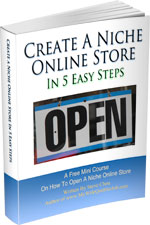
Ready To Get Serious About Starting An Online Business?
If you are really considering starting your own online business, then you have to check out my free mini course on How To Create A Niche Online Store In 5 Easy Steps.
In this 6 day mini course, I reveal the steps that my wife and I took to earn 100 thousand dollars in the span of just a year. Best of all, it's absolutely free!









